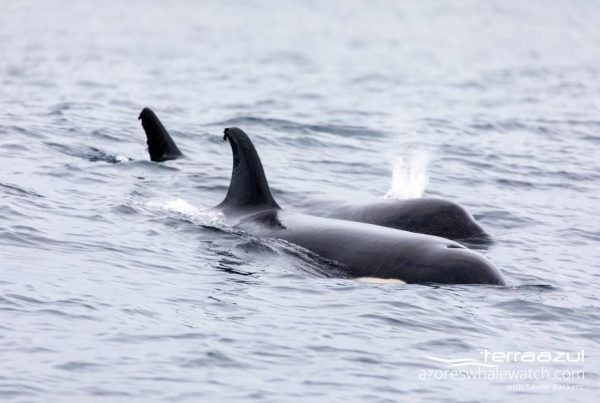
Hello Ocean lovers,
Yesterday was another special day, where our guests and crew got to experience and enjoy the amazing diversity in marine mammals, that we have here in the Azores!
Our trip started with a beautiful encounter of mother and calf Sperm whales (Physeter macrocephalus).. This is always a sight to remember, and same as with humans you can see a lot of socializing and a special bond in between mother and calf.

Two Sperm whales socializing
Not long and they got accompanied by other Sperm whales and suddenly we didn’t even know where too look as it was so many around us!
After one by one went for a dive to feed, we made our way to spot Risso’s dolphins (Grampus griseus) and as always it was an amazing experience watching their gentle and graceful movements through the water.

Risso’s Dolphin breaching next to a calf.
A few minutes later and a big group of Common Dolphins (Delphinus delphis) joined them so we could observe two very different behaviors of dolphins at the same time. The Common Dolphins were a lot more active and fast next to the Risso’s dolphins!
After a few minutes our lookout spotted something unusual not far from our spot, so we went to check it out..
Only seeing the fins, we thought it could be dolphins, but then we realized they were Beaked whales (Mesoplodon spp.)!!!

Beaked Whales (Mesoplodon spp.) Encyclopedia of Marine Mammals (Third Edition) 2018, Pages 595-602
Beaked Whales are rarely seen at the surface and there is not much information about them in the scientific world due to their preference for living in deep ocean waters. Also they are considered as quite shy animals, mostly avoiding boats and loud noises. That is, encounters usually don’t last very long.. And even not long enough to identify the exact species! The main features that distinguish the different species of beaked whales are the profile of the forehead, the length of the beak, and the shape and position of the teeth (Balcomb, 1989; Heyning, 1989; Mead, 1989a,b,c).
And as all the excitement wouldn’t be enough we got surprised by this little Loggerhead turtle (Caretta caretta) poking her head out of the water.

Loggerhead Turtle poking her head out of the water
On our morning tour today we were lucky to encounter two of our residents, the Bottlenose dolphins (Tursiops truncatus) and Sperm whales as well as striped dolphins. 🙂








